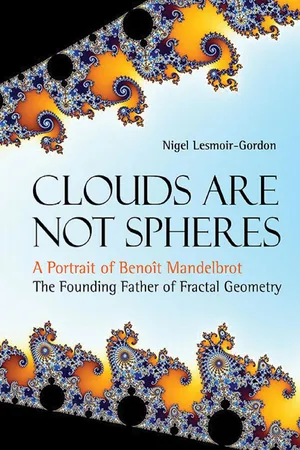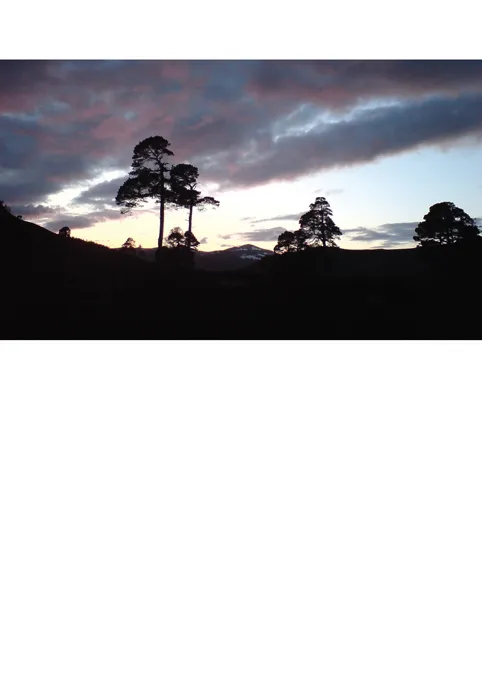
Clouds Are Not Spheres
A Portrait of Beno�t Mandelbrot, The Founding Father of Fractal Geometry
- 124 pages
- English
- ePUB (mobile friendly)
- Available on iOS & Android
Clouds Are Not Spheres
A Portrait of Beno�t Mandelbrot, The Founding Father of Fractal Geometry
About This Book
-->
The time is right, following Benoît Mandelbrot's death in 2010, to publish this landmark book about the life and work of this maverick math genius.
This compact book celebrates the life and achievements of Benoît Mandelbrot with the ideas of fractals presented in a way that can be understood by the interested lay-person. Mathematics is largely avoided. Instead, Mandelbrot's ideas and insights are described using a combination of intuition and pictures. The early part of the book is largely biographical, but it portrays well how Mandelbrot's life and ideas developed and led to the fractal notions that are surveyed in the latter parts of the book.
-->
CLOUDS PROMO from NIGEL LESMOIR-GORDON on Vimeo.
Contents:
- Foreword
- Preface
- Introduction
- The Early Years
- Caltech and to France Once More
- The USA, France and IBM
- The Birth of Fractal Geometry
- The Mandelbrot Set
- The Fractal Geometry of Nature
- The Art of Fractals
- Practical Fractals
- In Retrospect
- Benoit and Nigel
- Awards and Publications
-->
--> Readership: Aimed at a general inquisitively-minded readership. It will appeal to those seeking to understand fractal geometry in particular and mathematics in general. The book will appeal to readers of all ages. It will not be technically difficult or demand a deep understanding of mathematics. It will find a wide readership as a popular science book as well as appealing to academics, who like to read about the lives, struggles and achievements of their fellow scientists. The book is written for a very broad audience with minimal scientific or mathematical background. It may interest those who have come across fractals or the Mandelbrot set in some context and who want to find out more about what fractals are and about their progenitor. -->
Keywords:Benoît Mandelbrot;Fractal Geometry;Fractals;The Mandelbrot Set;Math;Geometry of NatureReview:
"There's much to recommend in this text. Nigel's collection of quotations taken from interviews he conducted provide valuable insights, many unavailable in print in any other place. Also, Nigel has assembled nice examples in chapters 7 and 8, some are familiar, some are less well-known, some will surprise readers. His overall picture is a useful addition to the literature about one of the most creative scientists of the 20th century. I look forward to seeing it in print."
Michael Frame
Yale University
"With its stunning pictures and lucid text, Clouds Are Not Spheres celebrates the works and the life of this remarkable man."
Emeritus Professor Ian Stewart
University of Warwick
"It is a fine popular biography that will appeal to a far wider audience than any other book which focuses on Mandelbrot."
Nathan Cohen
Fractal Antenna Systems, Inc.
"I read Nigel's Clouds Are Not Spheres and enjoyed it very much... Benoît influenced a new generation of mathematicians and scientists for whom fractals are an integral part of their knowledge, vision, applications and enjoyment... I recommend this publication."
Michael Shlesinger
Office of Naval Research, Arlington, USA
"The book is clearly written and easy to read and the illustrations are well-chosen and helpful. The reader will come away with a feeling for the inspirational nature of Mandelbrot's work as well as the opposition from some quarters that he had to encounter in getting his ideas accepted."
Kenneth Falconer
University of St Andrews, UK
Key Features:
- Fractal Geometry is the geometry of nature so the book is illustrated with beautiful images from the natural world: mountains, rivers, trees, lightning, dogs, people and computer generated simulations of natural forms. And of course stunning imagery of the glorious, infinite and mysterious Mandelbrot set
- The book features interviews with mathematicians (including Sir Arthur C Clarke and Ivar Giaver) talking about Fractal Geometry and their memories and impressions of Mandelbrot
- This is the first time that this unique material has been made available in print
Frequently asked questions
Information



Table of contents
- Cover
- Halftitle
- Title
- Copyright
- Foreword
- Contents
- Preface
- Introduction
- Fractal Geometry
- 01 The Early Years
- 02 Caltech and to France Once More
- 03 The USA, France and IBM
- 04 The Birth of Fractal Geometry
- 05 The Mandelbrot Set
- 06 The Fractal Geometry of Nature
- 07 The Art of Fractals
- 08 Practical Fractals
- 09 In Retrospect
- 010 Benoît and Nigel
- 011 Awards and Publications